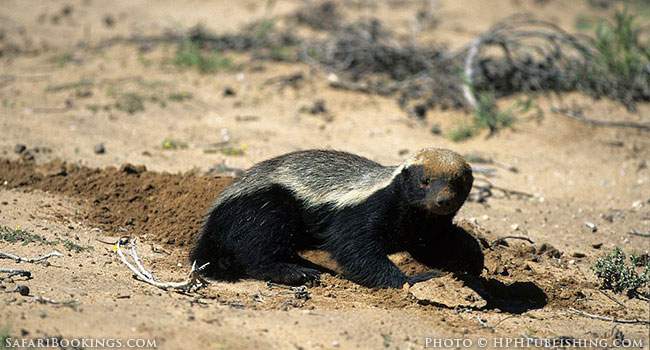
5 Fascinating Facts About the Honey Badger
 By Mike Unwin
By Mike Unwin
Mike is an award-winning wildlife writer, former editor of Travel Zambia magazine and author of the Bradt Guide to Southern African Wildlife.
Hard-nut or head-case? Meet the honey badger. Either way, this stocky little member of the weasel family has a ferocious reputation that belies its modest size. Known for its tenacity and aggression, even big cats will think twice before taking one on. Let us introduce you to yet another intriguing creature that is native to Africa, Southwest Asia and the Indian subcontinent – the fearless and resourceful honey badger.
- Honey badgers measure just 60–70 in length, with a 20–30cm tail. They can drive a young lion from its kill and overcome a three-meter python.
- The word is that the honey badger enjoys a mutual relationship with a bird called the greater honeyguide. According to folklore, the bird leads the badger to ransack a bees’ nest and then feeds on any larvae left behind. But there is no proof of this... yet.
- A honey badger’s skin is too tough for most predators’ teeth or bee stings to penetrate. additionally, it is so loose that the animal can twist and turn when seized by an attacker – in order to retaliate and escape.
- Beekeepers persecute honey badgers because of their pesky habit of breaking into beehives. However, this problem is totally solvable – simply by raising the beehives a meter or so off the ground, on steel poles.
- Honey badgers are partially plantigrade. Like bears, they walk on their soles rather than the toes of their feet.
Want To Go on an African Safari?
Click on the button below to compare African safaris offered by top-rated tour operators.
 By Mike Unwin
By Mike Unwin
Mike is an award-winning wildlife writer, former editor of Travel Zambia magazine and author of the Bradt Guide to Southern African Wildlife.
More About This AuthorAfrican Safari Tours
-
![7-Day Private Luxury Serengeti Wildebeest Migration Tour]()
7-Day Private Luxury Serengeti Wildebeest Migration Tour
$3,520 pp (USD)
Tanzania: Private tourLuxuryLodge & Tented Camp
You Visit: Arusha (Start), Tarangire NP, Central Serengeti NP, Northern Serengeti NP, Serengeti NP, Ngorongoro Crater, Kilimanjaro Airport (End)

Meru Slopes Tours & Safaris
5.0/5 – 464 Reviews
-
![7-Day Luxury Botswana Safari Tour]()
7-Day Luxury Botswana Safari Tour
$6,599 to $8,799 pp (USD)
Botswana: Private tourLuxuryLodge & Tented Bush Camp
You Visit: Maun (Start), Central Kalahari GR, Okavango Delta, Chobe NP, Kasane (End)

Wayfairer Travel
4.8/5 – 185 Reviews
-
![4-Day Lake Nakuru - the Pink Lake]()
4-Day Lake Nakuru - the Pink Lake
$1,265 to $2,068 pp (USD)
Kenya: Private tourLuxuryLodge & Tented Camp
You Visit: Nairobi (Start), Masai Mara NR, Lake Nakuru NP, Nairobi (End)

Tekko Tours and Travel
4.9/5 – 139 Reviews



 Subscribe to our newsletter
Subscribe to our newsletter
 Follow us on Instagram
Follow us on Instagram

_1813_5e20b935b89f3.gif)



